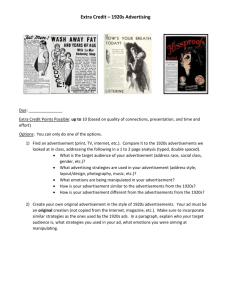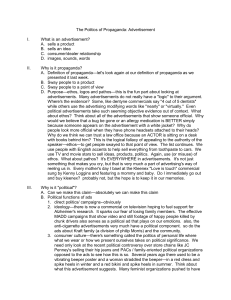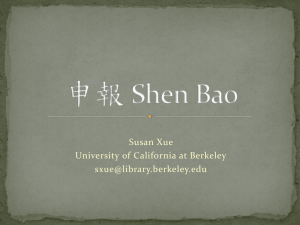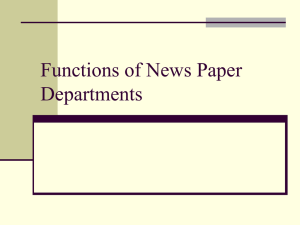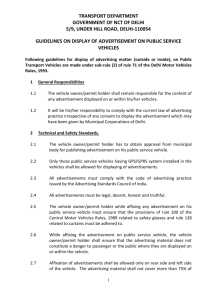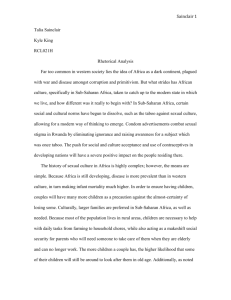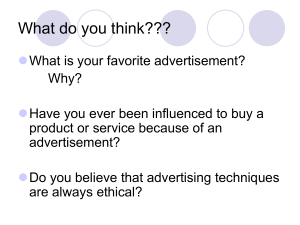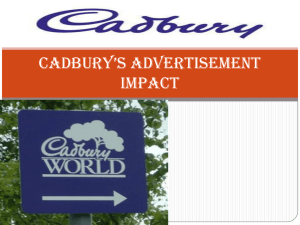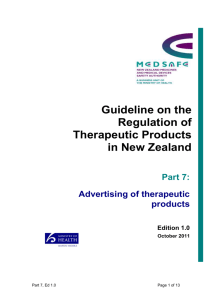1920sConsumerism_LP - mrsvanderley
advertisement
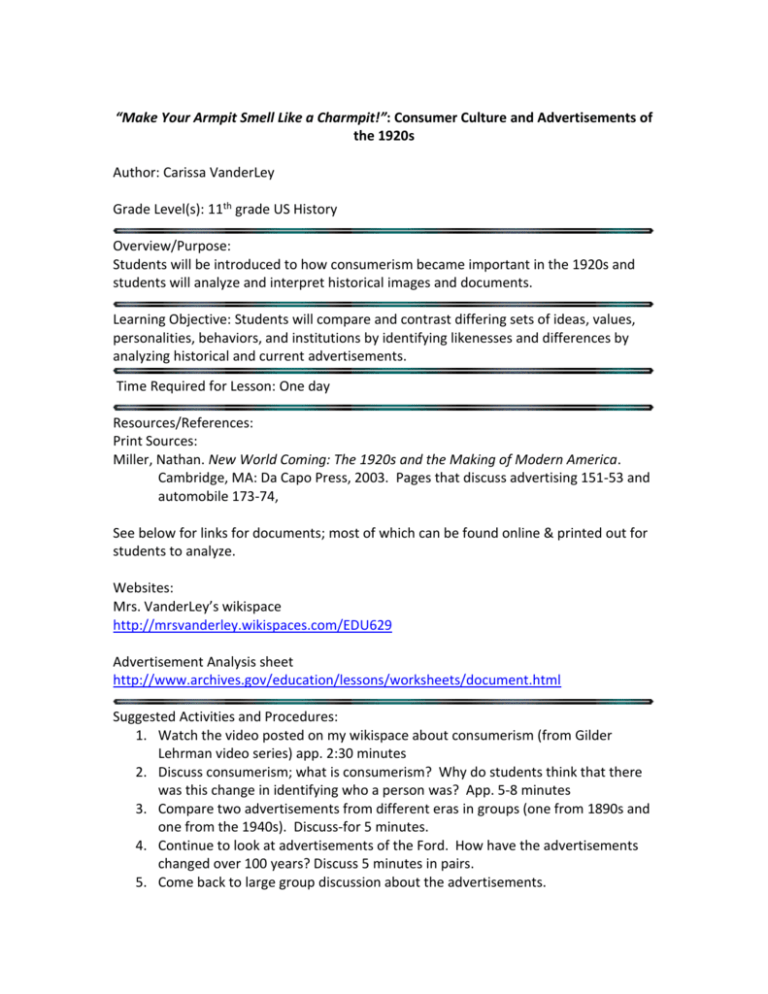
“Make Your Armpit Smell Like a Charmpit!”: Consumer Culture and Advertisements of the 1920s Author: Carissa VanderLey Grade Level(s): 11th grade US History Overview/Purpose: Students will be introduced to how consumerism became important in the 1920s and students will analyze and interpret historical images and documents. Learning Objective: Students will compare and contrast differing sets of ideas, values, personalities, behaviors, and institutions by identifying likenesses and differences by analyzing historical and current advertisements. Time Required for Lesson: One day Resources/References: Print Sources: Miller, Nathan. New World Coming: The 1920s and the Making of Modern America. Cambridge, MA: Da Capo Press, 2003. Pages that discuss advertising 151-53 and automobile 173-74, See below for links for documents; most of which can be found online & printed out for students to analyze. Websites: Mrs. VanderLey’s wikispace http://mrsvanderley.wikispaces.com/EDU629 Advertisement Analysis sheet http://www.archives.gov/education/lessons/worksheets/document.html Suggested Activities and Procedures: 1. Watch the video posted on my wikispace about consumerism (from Gilder Lehrman video series) app. 2:30 minutes 2. Discuss consumerism; what is consumerism? Why do students think that there was this change in identifying who a person was? App. 5-8 minutes 3. Compare two advertisements from different eras in groups (one from 1890s and one from the 1940s). Discuss-for 5 minutes. 4. Continue to look at advertisements of the Ford. How have the advertisements changed over 100 years? Discuss 5 minutes in pairs. 5. Come back to large group discussion about the advertisements. 6. Assignment-Students will be looking at advertisements that focus on consumer culture and some of the stereotypes of advertising. 7. See ‘Assignment sheet’. Teacher Notes and Suggestions: It is best to have all documents printed out and ready to go for students. Encourage class discussion with open-end questions and relate to what kids already know about advertising, how it has changed, and discuss what the role of advertising is (is it to inform or persuade?). Student Materials/Instructions: Lesson Websites: http://mrsvanderley.wikispaces.com/EDU629 https://www.gilderlehrman.org/multimedia#3416 (need to have a login-so video is posted on my wikispace) http://library.duke.edu/digitalcollections/adaccess/ Students will use this website to conduct their search for advertisements. Extending the Lesson: To extend this lesson, the students can look at advertisements of today and specifically advertisements of products that they purchase. The media has changed although, students can look at their FaceBook page or Twitter accounts to see what kinds of advertisements come up on their accounts. What are some changes of advertisements of today? Are there any changes? Assessment(s): Rubrics are found below. Content Standards: SD Content Standards: 9-12.US.1.1. Students are able to explain the cause-effect relationships and legacy that distinguish significant historical periods from Reconstruction to the present. National US History Standards: United States History Era 7: Standard 3B The student understands how a modern capitalist economy emerged in the 1920s. Students will be able to examine the changes in the modern corporation, including labor policies and the advent of mass advertising and sales techniques. Miscellaneous Information: I have used a similar lesson plan in the Sociology class that I teach. It focuses on how advertising agencies, popular culture and the media all prey upon adolescents. This lesson could be used in an economic or marketing class to discuss the rise of mass advertising. While in groups of two (2), look at the advertisements; what are some of the differences of the two? Look at the use of the images/pictures, the text (bold, coloring, wording). What is this advertisement appeal? (is it factual, emotional or sexual?) #1 Advertisement #2 Advertisement ADVERTISEMENT #1 Williams’ Shaving Stick Ad C W H. M. Stanley (1890) http://www.vintageadbrowser.com/beauty-and-hygiene-ads-1890s ADVERTISEMENT #2 http://library.duke.edu/digitalcollections/adaccess_BH0645/ One aspect of the consumer culture was that manufacturers kept introducing more useful and enticing products for consumers to purchase. At the same time credit became available to Americans. Take a look how the car changed from a mode of transportation to a symbol of status and freedom for a person. Look at how the advertisements have changed. Who is the target audience of these advertisements? What did advertisers use to persuade people to buy these cars? 1912 Advertisement http://earthsnaturalsolutions.com/100-years-ago-today-1912-ford-caradvertisement/ http://www.hfmgv.org/exhibits/showroom/1908/companion.jpg http://www.coloribus.com/adsarchive/prints/ford-fusion-key-skyline-11864205/ Assignment Sheet Looking at the AdAccess Web Site you will need to look at a variety of advertisements. You will need to look specifically at the different stereotypes (like gender and racial) that are portrayed in the various advertisements. Fill out the form below and write a short response (500 words minimum) on the existence and the persistence of the stereotypes in the advertisements you have chosen. You should view (and print out to final report) at least three or more different types of advertisements to get a better scope of the project. Ad #1 What is the name of the company that made this product? What is the company’s slogan or motto? What type of product and/or service is being advertised? What are the claims or promises made in the advertisement? Who is the target audience of this advertisement? What, if any, are some biases that can be found in the advertisement? Ad. #2 Ad. #3 Ad. #4 Essay Rubric Criteria 4 3 2 1 The claim I make a claim and explain why it is controversial. I make a claim but don't explain why it is controversial. My claim is buried, confused and/or unclear. I don't say what my argument or claim is. Reasons in support of the claim I give clear and accurate reasons in support of my claim. I give reasons in support of my claim but I may overlook important reasons. I give 1 or 2 weak reasons that don't support my claim and/or irrelevant or confusing reasons. I do not give convincing reasons in support of my claim. Reasons against the claim I discuss the reasons against my claim and explain why it is valid anyway. I discuss the reasons against my claim but leave some reasons out and/or don't explain why the claim still stands. I say that there are reasons against the claim but I don't discuss them. I do not acknowledge or discuss the reasons against the claim. Organization My writing has a compelling opening, an informative middle and a satisfying conclusion. My writing has a beginning, middle and end. It marches along but doesn't dance. My writing is organized but sometimes gets off topic. My writing is aimless and disorganized. Voice and tone It sounds like I care about my argument. I show how I think and feel about it. My tone is OK but my paper could have been written by anyone. I need to tell more about how I think and feel. My writing is bland or pretentious. There is either no hint of a real person in it or it sounds like I'm a fake. My writing is too formal or too informal. It sounds like I don't like the topic of the essay. Word choice The words I use are striking but natural, varied and vivid. I make routine word choices. The words I use are often dull or uninspired or sound like I am trying too hard to impress. I use the same words over and over and over and over. Some words may be confusing to a reader. Conventions I use correct grammar, spelling, and punctuation. I generally use correct conventions. I have a couple of errors I should fix. I have enough errors in my essay to distract a reader. Numerous errors make my paper hard to read. Rubric from: http://www.old-pz.gse.harvard.edu/Research/RubricsSelfPE.htm
